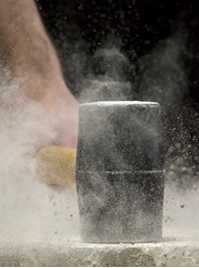INDOOR ENVIRONMENTAL QUALITY
Maintaining Indoor Environmental Quality (IEQ) during Construction and Renovation

Construction and renovation projects in office settings can adversely affect building occupants by the release of airborne particulates, biological contaminants, and gases. Careful planning for IEQ and the prevention of exposure during these activities is essential.

Particulates
Particulate material such as dusts and fibers are likely to be produced during construction and renovation activities. Sources include drywall, plaster, concrete, soil, wood, masonry, flooring, roofing, and ductwork. Non toxic dusts are irritants and can exacerbate lung conditions such as asthma and chronic obstructive lung disease.
Materials that contain fibers such as fiberglass composite materials or insulation can irritate the skin, eyes and respiratory tract when disbursed in the air and/or inhaled. Toxic dusts containing asbestos, polychlorinated biphenyls (PCBs) or lead can cause serious long-term health effects.
For all construction and renovation dusts, a plan to minimize exposure should be implemented. Appropriate containment should be in place to prevent disbursement into occupied areas. Certified and licensed contractors are required to conduct renovation.
Biological Materials
Chronic dampness from water intrusion leads to increased bacteria, mold and other microbes in a building environment. Microbial-contaminated materials require special precautions prior to demolition to prevent biological dusts from dispersing in the occupied space. Another example of biological contamination is an accumulation of bird or rodent droppings. In both cases, uncontrolled disturbances could spread potentially allergenic or infectious dust to occupied building areas. It is therefore important to implement appropriate engineering controls and decontamination techniques to minimize all occupant exposure.
Volatile Organic Compounds (VOCs)

Some building materials release gases called VOCs. Common VOC sources include:
- Caulks, sealants, and coatings
- Adhesives
- Paints, varnishes and/or stains
- Wall coverings
- Cleaning agents
- Fuels and combustion products
- Carpeting
- Vinyl flooring
- Fabric materials & furnishings
Occupants with VOC exposure often report disagreeable odors, exacerbation of asthma, irritation to the eyes, nose and throat, headaches and drowsiness. Health symptoms associated with VOC exposure can be minimized by choosing low VOC emitting products.
- Page last reviewed: May 17, 2013
- Page last updated: June 18, 2013
- Content source:
- National Institute for Occupational Safety and Health Respiratory Health Division


 ShareCompartir
ShareCompartir